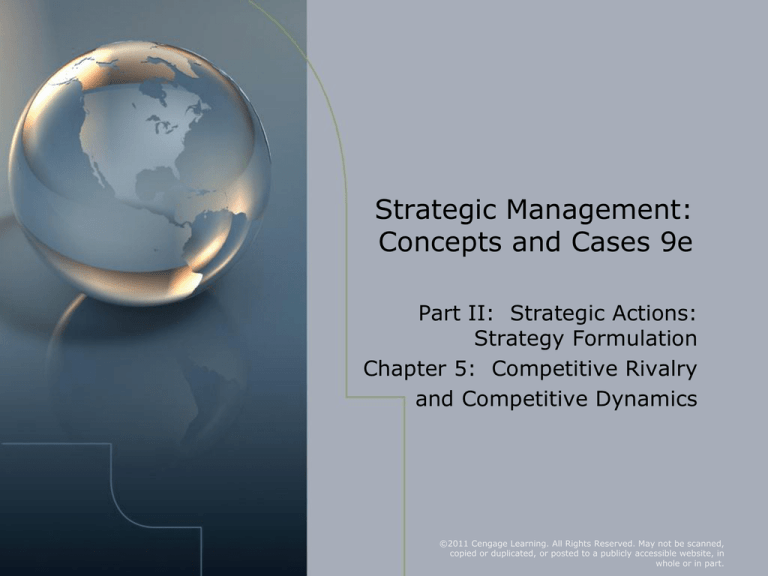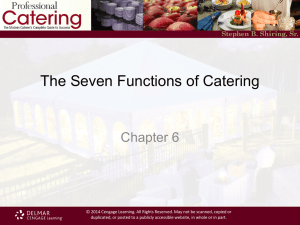
Strategic Management:
Concepts and Cases 9e
Part II: Strategic Actions:
Strategy Formulation
Chapter 5: Competitive Rivalry
and Competitive Dynamics
©2011 Cengage Learning. All Rights Reserved. May not be scanned,
copied or duplicated, or posted to a publicly accessible website, in
whole or in part.
Chapter 5: Competitive Rivalry and
Competitive Dynamics
• Overview:
– Competitors, competitive rivalry, competitive behavior
and competitive dynamics
– Market commonality and resource similarity: Building
blocks of competitor analysis
– Competitive actions: Awareness, motivation and ability
– Factors driving competitor’s competitive actions
– Competitor’s response to actions taken against it
– Competitive dynamics in slow, fast and standard-cycle
markets
©2011 Cengage Learning. All Rights Reserved. May not be scanned, copied or duplicated, or posted to a publicly accessible website, in whole or in part.
Introduction and Definitions
• Competitors
– Firms operating in the same market, offering similar products and targeting
similar customers
• Competitive Rivalry
– Ongoing set of competitive actions and competitive responses occurring between
competitors as they contend with each other for an advantageous market position
• Competitive Behavior
– Set of competitive actions and competitive responses the firm takes to build or
defend its competitive advantages and to improve its market position
• Multimarket Competition
– Firms competing against one another in several product or geographic markets
• Competitive Dynamics
– Total set of actions and responses of all firms competing within a market
©2011 Cengage Learning. All Rights Reserved. May not be scanned, copied or duplicated, or posted to a publicly accessible website, in whole or in part.
From Competitors to Competitive Dynamics
©2011 Cengage Learning. All Rights Reserved. May not be scanned, copied or duplicated, or posted to a publicly accessible website, in whole or in part.
Model of Competitive Rivalry
• Model of Competitive Rivalry
–
–
–
–
Over time firms take competitive actions/reactions
Pattern shows firms are mutually interdependent
Firm level rivalry is usually dynamic and complex
Foundation for successfully building and using capabilities and
core competencies to gain an advantageous market position
©2011 Cengage Learning. All Rights Reserved. May not be scanned, copied or duplicated, or posted to a publicly accessible website, in whole or in part.
Competitor Analysis
• Market Commonality: Each industry composed of various markets
which can be subdivided into (segments)
• Resource Similarity: Extent to which firm’s tangible/intangible
resources are comparable to competitor’s in type and amount
• Market commonality & resource similarity influence three drivers of
competitive behavior
– Awareness
– Motivation
– Ability
• Other influences include resource dissimilarity
– The greater the resource imbalance between acting firm and
competitors or potential responders, the greater will be the delay
in response
©2011 Cengage Learning. All Rights Reserved. May not be scanned, copied or duplicated, or posted to a publicly accessible website, in whole or in part.
Competitive Rivalry
• Important to understand competitor’s awareness,
motivation and ability in order to predict the likelihood of
an attack – study ‘likelihood of attack’ factors
• What are the strategic and tactical actions?
– Strategic actions/responses: market-based moves that
signify a significant commitment of organizational resources to
pursue a specific strategy
• Difficult to implement and reverse
– Tactical actions/responses: market-based moves that involve
fewer resources to fine-tune a strategy that is already in place
• Easy to implement and reverse
©2011 Cengage Learning. All Rights Reserved. May not be scanned, copied or duplicated, or posted to a publicly accessible website, in whole or in part.
Interfirm Rivalry: Likelihood of Attack
• Three possible ‘likelihood of response’ actions
– 1. First Mover Incentives
– 2. Organizational Size
– 3. Quality
• Additional factors affect the likelihood a firm will
competitively respond to a competitor’s actions:
– 1. Types and effectiveness of the competitive action
– 2. Actor’s Reputation
– 3. Dependence on the Market
• Finally, if the action significantly strengthens or weakens
the firm's competitive position
©2011 Cengage Learning. All Rights Reserved. May not be scanned, copied or duplicated, or posted to a publicly accessible website, in whole or in part.
Competitive Dynamics: 3 Market Cycles
1. Slow-Cycle Markets
– Markets in which the firm's competitive advantages are shielded
from imitation for long periods of time, and in which imitation is
costly
– Build a one-of-a-kind competitive advantage which creates
sustainability
– Once a proprietary advantage is developed, competitive behavior
should be oriented to protecting, maintaining, and extending that
advantage
– Organizational structure should be used to effectively support
strategic efforts
©2011 Cengage Learning. All Rights Reserved. May not be scanned, copied or duplicated, or posted to a publicly accessible website, in whole or in part.
Gradual Erosion of a Sustained Competitive
Advantage
©2011 Cengage Learning. All Rights Reserved. May not be scanned, copied or duplicated, or posted to a publicly accessible website, in whole or in part.
Competitive Dynamics: 3 Market Cycles
(Cont’d)
2. Fast-Cycle Markets
– Markets in which the firm's capabilities that contribute to
competitive advantages are not shielded from imitation and
where imitation is often rapid and inexpensive
– Focus: learning how to rapidly and continuously develop new
competitive advantages that are superior to those they replace
(creating innovation)
– Avoid loyalty to any one product, possibly cannibalizing their own
current products to launch new ones before competitors learn
how to do so through successful imitation
– Continually try to move on to another temporary competitive
advantage before competitors can respond to the first one
©2011 Cengage Learning. All Rights Reserved. May not be scanned, copied or duplicated, or posted to a publicly accessible website, in whole or in part.
Developing Temporary Advantages to Create
Sustained Advantage
©2011 Cengage Learning. All Rights Reserved. May not be scanned, copied or duplicated, or posted to a publicly accessible website, in whole or in part.
Competitive Dynamics: 3 Market Cycles
(Cont’d)
3. Standard-Cycle Markets
– Markets where firm’s competitive advantages are moderately
shielded from imitation and where imitation is moderately costly
– Competitive advantages partially sustained as quality is
continuously upgraded
– Seek to serve many customers and gain a large market share
– Gain brand loyalty through brand names
– Careful operational control / manage a consistent experience for
the customer
©2011 Cengage Learning. All Rights Reserved. May not be scanned, copied or duplicated, or posted to a publicly accessible website, in whole or in part.








